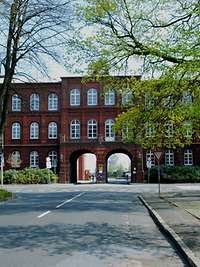
Information on the Naval Arsenal
The Naval Arsenal carries out maintenance activities and repairs to the units afloat and the shore-based units of the German Navy.


For more than 60 years, the training workshop of the Naval Arsenal (Marinearsenal, MArsMarinearsenal) in Wilhelmshaven has been preparing adolescents for commercial and technical occupations and has helped more than 5,000 young people to build a successful professional life along the way. Due to the constant technological changes and the need for qualified and committed employees in the Bundeswehr and in the private sector, the occupational profiles have been continuously adapted to fit the state of the art.
Every year a large number of young people starts their career training in one of five training occupations in Wilhelmshaven, one of the oldest and largest training workshops of the Bundeswehr.
The training workshop has a rich history and long tradition.
On the occasion of its 60th anniversary, let us take a look at its timeline starting with the founding of the training workshop in 1961 all the way to the year 2021.
Our story begins on 1 April 1961.
Back then, the first 40 apprentices began their training at the Naval Arsenal Wilhelmshaven.
27 electrical mechanics and 13 precision mechanics embarked on their occupational journey at the site.
Due to the bad infrastructure at the time, though, the location for the training workshop had to be rented outside of the shipyard. A former post office building was chosen as the first provisional training site.
At the same time, plans were already under way for a new and larger training workshop. August 1961 saw the beginning of the construction of the new building and on 1 February 1963, the training workshop was moved to its new location.
In 1967, the total number of apprentices was increased to 72 as more training occupations were offered. As a result, the new training workshop quickly became too cramped as well. Fortunately, the former “Lehrlingshochhaus”, or apprentices’ tower, built in 1938, offered an alternative. It underwent renovation starting in April 1968 and has been in use ever since.
By 1970, as many as 230 apprentices had successfully completed their training. Even back then, this made the “Marinearsenal” (MArsMarinearsenal) the largest civilian apprenticeship employer of the Bundeswehr.
April 1975 marked the first time that more than one hundred young people – 112, to be exact – started their apprenticeship. Among them was the first female apprentice of the training workshop.
The following year, the number of available apprenticeship positions was raised even further to 132.
Starting from 1978, the training workshop offered another new feature: an introductory seminar aiming at facilitating the start of professional life, which incidentally has been conducted successfully ever since.
In the 1980s, the course and training offer was expanded even further. The 80s saw not only the employment of the first lathe operator, but also the implementation of a microcomputer course, the basic course in hydraulics for locksmiths and the basic course in CNC operation for lathe operators.
In roughly the same period, the metalworking and electrical professions were reorganized, culminating in the required restructuring of the respective trainings.
Technical evolution never stops. That is why in 1989, a facility for microcomputers and a measuring laboratory were established to ensure improved training.
Up until this point, the number of apprentices had been on a steady rise, but with the advent of the 1990s, this was going to change. Due to cost-saving measures of the Federal Government, the number of apprenticeship positions dropped from originally 132 to merely 33 between 1990 and 1995.
However, as early as 1996 the next change manifested itself: The yearly number of apprenticeship positions was increased to 60 again.
Today, young people can choose between five different training occupations at the site in Wilhelmshaven. The Naval Arsenal recruits 12 new apprentices per year and training occupation.
Additionally, the training workshop in Kiel-Ellerbek opened in the fall of 2020 and has started training 12 new apprentices in one of two training occupations each year.
Also, the training workshop of the Naval Arsenal in Wilhelmshaven regularly offers internships for young students. They provide young people with an opportunity to get to know the available training occupations in the Naval Arsenal and obtain information for their career choices.
In future, training young people will continue to be a task of great importance as it is the precondition for the availability of highly qualified staff for the repair of naval equipment.
The training workshops of the “Marinearsenal” will aim at fulfilling this goal in the coming years and will do their part to provide the best framework possible for the apprentices’ start into their professional life.

The Naval Arsenal carries out maintenance activities and repairs to the units afloat and the shore-based units of the German Navy.